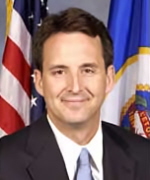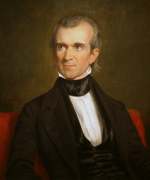Could Pawlenty Win the Presidency Without Minnesota?
(This report is the second installment in Smart Politics’ ‘Pathway to the White House’ Series. The first report analyzed from what state presidents come).

The Star Tribune finding that there is barely lukewarm support in Pawlenty’s home state for him to seek the highest office in the land, comes as Pawlenty has been running a distant fifth or sixth in (very) early national GOP horserace polls behind more well-known potential candidates such as Mitt Romney, Sarah Palin, Mike Huckabee, and Newt Gingrich.
While Pawlenty’s support would likely grow nationwide once he launched an official candidacy (he launches his Freedom First PAC on Thursday), the new Minnesota Poll raises the question – could Pawlenty win the presidency without carrying his home state of Minnesota?
While it is still 2.5 years out from even the presidential primaries, the question is not a far-fetched one to consider from one perspective – a mid-September Rasmussen poll found half of Minnesotans to believe Pawlenty will win the GOP nomination should he run for President.
As analyzed by Smart Politics last week, no president has come from Minnesota to date, and only one has come from the Upper Midwest region (Herbert Hoover, from Iowa, in 1928).
Still, history has demonstrated that it is (nearly) a necessary though not a sufficient condition that presidential nominees must carry their home state if they wish to win the presidency.
A Smart Politics analysis of the 56 presidential elections since 1789 found that all but two presidents carried their home state en route to victory.

Then, in 1916, Democratic incumbent Woodrow Wilson lost his home state of New Jersey by 11.7 points to New York GOPer Charles Hughes. Wilson had carried New Jersey by 7.6 points in 1912 over New Yorker Teddy Roosevelt.
That’s the entire list.
As such, it does not appear that Pawlenty could have much success in 2012 if he fails to at least enlist Minnesotans among his supporters for such a bid.
Home State Presidential Vote for U.S. Presidents
|
Year
|
President
|
State
|
Won
|
Percent
|
MoV
|
|
2008
|
Obama
|
Illinois
|
Yes
|
61.9
|
25.1
|
|
2004
|
Bush
|
Texas
|
Yes
|
61.1
|
22.9
|
|
2000
|
Bush
|
Texas
|
Yes
|
59.3
|
21.3
|
|
1996
|
Clinton
|
Arkansas
|
Yes
|
53.7
|
16.9
|
|
1992
|
Clinton
|
Arkansas
|
Yes
|
53.2
|
17.7
|
|
1988
|
Bush
|
Texas
|
Yes
|
56.0
|
12.6
|
|
1984
|
Reagan
|
California
|
Yes
|
57.5
|
16.2
|
|
1980
|
Reagan
|
California
|
Yes
|
52.7
|
16.8
|
|
1976
|
Carter
|
Georgia
|
Yes
|
66.7
|
33.8
|
|
1972
|
Nixon
|
California
|
Yes
|
55.0
|
13.5
|
|
1968
|
Nixon
|
California
|
Yes
|
47.8
|
3.1
|
|
1964
|
L. Johnson
|
Texas
|
Yes
|
63.3
|
26.8
|
|
1960
|
Kennedy
|
Massachusetts
|
Yes
|
60.2
|
20.7
|
|
1956
|
Eisenhower
|
Pennsylvania
|
Yes
|
56.5
|
13.2
|
|
1952
|
Eisenhower
|
Pennsylvania
|
Yes
|
52.7
|
5.9
|
|
1948
|
Truman
|
Missouri
|
Yes
|
58.1
|
16.6
|
|
1944
|
F. Roosevelt
|
New York
|
Yes
|
52.3
|
5.0
|
|
1940
|
F. Roosevelt
|
New York
|
Yes
|
51.6
|
3.6
|
|
1936
|
F. Roosevelt
|
New York
|
Yes
|
58.9
|
19.9
|
|
1932
|
F. Roosevelt
|
New York
|
Yes
|
54.1
|
12.7
|
|
1928
|
Hoover
|
Iowa
|
Yes
|
61.8
|
24.2
|
|
1924
|
Coolidge
|
Massachusetts
|
Yes
|
62.3
|
37.4
|
|
1920
|
Harding
|
Ohio
|
Yes
|
58.5
|
19.9
|
|
1916
|
Wilson
|
New Jersey
|
No
|
42.7
|
-11.7
|
|
1912
|
Wilson
|
New Jersey
|
Yes
|
41.2
|
7.6
|
|
1908
|
Taft
|
Ohio
|
Yes
|
51.0
|
6.2
|
|
1904
|
T. Roosevelt
|
New York
|
Yes
|
53.1
|
10.9
|
|
1900
|
McKinley
|
Ohio
|
Yes
|
52.3
|
6.6
|
|
1896
|
McKinley
|
Ohio
|
Yes
|
51.9
|
4.8
|
|
1892
|
Cleveland
|
New York
|
Yes
|
49.0
|
3.4
|
|
1888
|
B. Harrison
|
Indiana
|
Yes
|
49.1
|
0.4
|
|
1884
|
Cleveland
|
New York
|
Yes
|
48.3
|
0.1
|
|
1880
|
Garfield
|
Ohio
|
Yes
|
51.7
|
4.7
|
|
1876
|
Hayes
|
Ohio
|
Yes
|
50.2
|
1.1
|
|
1872
|
Grant
|
Ohio
|
Yes
|
53.2
|
7.1
|
|
1868
|
Grant
|
Ohio
|
Yes
|
54.0
|
8.0
|
|
1864
|
Lincoln
|
Illinois
|
Yes
|
54.4
|
8.8
|
|
1860
|
Lincoln
|
Illinois
|
Yes
|
50.7
|
3.5
|
|
1856
|
Buchanan
|
Pennsylvania
|
Yes
|
50.1
|
18.1
|
|
1852
|
Pierce
|
New Hampshire
|
Yes
|
56.4
|
25.8
|
|
1848
|
Taylor
|
Louisiana
|
Yes
|
54.6
|
9.2
|
|
1844
|
Polk
|
Tennessee
|
No
|
50.0
|
-0.1
|
|
1840
|
W.H. Harrison
|
Ohio
|
Yes
|
54.1
|
8.5
|
|
1836
|
Van Buren
|
New York
|
Yes
|
54.6
|
9.3
|
|
1832
|
Jackson
|
Tennessee
|
Yes
|
95.4
|
90.8
|
|
1828
|
Jackson
|
Tennessee
|
Yes
|
95.2
|
90.4
|
|
1824
|
J.Q. Adams
|
Massachusetts
|
Yes
|
73.0
|
57.2
|
|
1820
|
Monroe
|
Virginia
|
Yes
|
—
|
—
|
|
1816
|
Monroe
|
Virginia
|
Yes
|
—
|
—
|
|
1812
|
Madison
|
Virginia
|
Yes
|
—
|
—
|
|
1808
|
Madison
|
Virginia
|
Yes
|
N/A
|
N/A
|
|
1804
|
Jefferson
|
Virginia
|
Yes
|
N/A
|
N/A
|
|
1800
|
Jefferson
|
Virginia
|
Yes
|
N/A
|
N/A
|
|
1796
|
J. Adams
|
Massachusetts
|
Yes
|
N/A
|
N/A
|
|
1792
|
Washington
|
Virginia
|
Yes
|
N/A
|
N/A
|
|
1789
|
Washington
|
Virginia
|
Yes
|
N/A
|
N/A
|
|
|
|
|
|
56.4
|
16.5
|
Follow Smart Politics on Twitter.

Oh for crying out loud! The president is nine months into his first four-year term and you are already publishing stories like this. Can we please be without a presidential campaign — and stories like these — for about two years??????????
Yes, it sad how the mouth of the media needs to be fed. More web hits, more viewers, more eyes, more listeners, etc… It’s all about the numbers and how they translate to advertising dollars. [with the exception of smart politics] No wonder the attention span of the media is about a nanosecond….
Its kind of fun being in an indeterminate stage regarding what’s next. The real fun begins when they realize that they have nothing.
Either banish the term “home state” with regard to presidential candidates, or, alternatively, add R M Nixon for his 1968 bid to the very short list, since he, like Eisenhower in 1952 and Robert Francis Kennedy by 1964 in his US Senate run, was empirically a New Yorker at that particular time.
A handful of candidates have made this terrain a methodological quagmire.